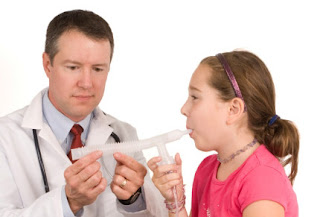Bronchial Asthma Symptoms In Children
 |
| Photo via:asthma-and-allergy.org |
There are many times of the year when bronchial infections seem to increase. While not a researcher or medical professional, I have noticed that cold and rainy weather along with the changes in seasons, my kids seem to have more than their share of colds and flu like symptoms.
What Are the Causes of Bronchial Asthma in Children?
If your child has bronchial asthma, this inflammation of the lungs can cause serious difficulties with breathing and can be a life-threatening condition.
The symptoms of bronchial asthma in children are treatable through lifestyle changes and medications and include wheezing, coughing, fatigue and coughing. According to the National Library of Medicine and the Mayo Clinic, the causes of bronchial asthma in children include environmental irritants and respiratory infections.
Bronchial Asthma in Children
Most experts recommend that a child who suffers from this condition attempt to limit any possible contact with allergens that can make symptoms worse.
This is sometimes easier said than done given the fact that many children are active and enjoy going outside to play with their friends. While it is true that fast-acting inhalers can provide temporary relief from the onset of symptoms, most parents want their children to have a longer lasting solution to the problem.
This makes sense considering the fact that bronchial asthma in children is a condition that can largely be made to go away over time. It really depends on a variety of variables.
Do not be afraid to make an appointment for you and your child to see a physician. Sometimes parents are concerned about the cost associated with seeking healthcare for themselves or their children.
However, it's simply not fair to the child. You really need to make an effort to take them in to get treated for their condition if you see that it is causing them a great deal of distress and discomfort.
Here's the bottom line: bronchial asthma in childrenis a treatable condition whose symptoms can largely be mitigated through a combination of strategies prescribed by your doctor.
Bronchial Asthma In Children
Asthma can be a very expensive and problematic condition to deal with. an air purifier can help to eliminate allergenic particles or toxic contaminants from the air. when used inside your home, an air purifier can help make the air that you and your family breathe cleaner. this is one of the reasons, a person with Asthma could be in the market for a new air purifier, if not now then in the future. I personally have two Austin Air Filters in my own home to help with Allergies.
Bronchial asthma is one of the most common health issues affecting children, with sometimes life threatening consequences. It is caused by inflammation of the bronchial tubes in which the bronchial lining tries to protect the body from allergens by increasing mucous, swelling of the mucosal tissues and contraction of the muscles. According to the American Lung Association, this inflammation is produced by allergies, viral respiratory infections, and airborne irritants among other causes.
Symptoms of Asthma: Bronchial, Cardiac, In Children, Exercise Induced Asthma
It is also important to know the signs and symptoms of asthma, so you know what to look out for in cases of attacks. Here are among the most common of them:
- Wheezing: This is a squeaky or whistling sound that is heard when you breathe.
- Shortness of breath: A number of people say that they feel like they are out of breath or that they can’t their breath when they have asthma. This is just like not being able to get air from out of your lungs.
- Coughing: This is usually worse during early in the morning and at nighttime making it very hard to get enough sleep.
Asthma is one of the most common chronic diseases auftetenden. Up to ten percent of children are affected, in adults, the rate is about five percent.
Asthma is a chronic respiratory disease that causes coughing and wheezing. In addition to the permanent symptoms usually occur paroxysmal exacerbations. During asthma attack, the bronchi constrict spasmodically, the bronchial mucosa becomes inflamed, swells and forms increased mucus. The thickened mucus plugs the opening of the bronchial tubes.
The most common trigger for an asthma attack is a viral respiratory infection such as a cold or flu. In addition, allergic reactions to certain substances such as food, animal dander or pollen cause asthma attacks.
Features of Asthma
Asthma is the most common chronic disease in children.
Most asthma is developed between the fourth and fifth year.
In about 50 percent of the children's asthma disappears, when they grow up.
The lighter the asthma is, the greater are the chances that the disease will disappear.
Related To:Asthma Symptoms in Children
Symptoms of Asthma in Children Asthma symptoms range from mild to severe ones. ... Bronchial Asthma Symptoms and Treatment; Mild Asthma Symptoms;
www.buzzle.com
Bronchial Asthma in Children - Pathogenesis, Clinical ...In asthma the chronic sinus RX can show signs of rhinosinusitis or polyps. • Respiratory function tests. ... Differential Diagnosis Of Bronchial Asthma In Children
www.indiastudychannel.com






